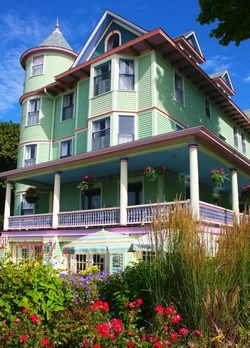The Lost Industries of Mackinac: What Was Here Before the Tourism Boom?
Introduction
Mackinac Island is now a peaceful, car-free vacation spot. It’s famous for fudge, horse-drawn carriages, and lake views. But long before tourists arrived, the island was a center of trade and work. Industries once shaped daily life here. Many people lived on the island to work, not relax.
Before tourism, Mackinac Island was a busy economic hub. It was more than just a scenic place. From the 1600s through the 1800s, Mackinac played a vital role. It connected the Great Lakes through trade and shipping. Over time, industries like fishing, shipping, and stonework built its early economy. Today, most of that history is hidden beneath souvenir shops and gift stores. But if you look closely, you’ll still find signs of the island’s working past.
Fur Trade Era: Mackinac’s First Major Industry
The fur trade was Mackinac Island’s first major industry. In the 17th and 18th centuries, the island became a trading post. French traders, then British and American fur companies, controlled the trade. The island’s location between Lake Huron and Lake Michigan made it ideal.
One of the biggest companies was the American Fur Company. It was founded by John Jacob Astor, one of America’s richest men. He used Mackinac as a center for fur collection and shipping. Traders would bring animal pelts from all over the Midwest. These furs were packed on ships and sent to markets in Europe and the U.S.
The fur trade brought:
- Jobs for trappers, boatmen, and Native American traders
- Wealth for local merchants and shipping companies
- Growth in the island’s population and infrastructure
By the mid-1800s, the fur trade slowed down. Animal populations fell, and fashion trends changed. But its impact on Mackinac’s history is lasting.
Fishing Industry: A Life Built Around the Water
After the fur trade declined, fishing became important. The island waters were rich with whitefish and trout. Fishermen would catch and sell them to cities like Detroit and Chicago.
Fish were packed in barrels and shipped by boat. Fishing supported many local families and workers. It also helped build docks and storage areas on the island. As the waters became overfished, the industry faded. But the fishing legacy lives on in Mackinac’s culture.
Industrial Growth and Infrastructure
Mackinac Island is known for its quiet beauty today. But in the 1800s, it played a bigger role in regional industry. The island wasn’t just a tourist spot. It was connected to the working economy of the Great Lakes. Several key industries helped build that foundation.
Logging and Lumber Transport
Mackinac Island was not home to large forests. However, it supported the logging industry in nearby regions. Logs were floated from the Upper Peninsula and mainland forests. Mackinac’s harbor made it a key stop for timber transport.
Workers helped move and sort logs along the shipping routes. The wood was used for:
- Building homes and businesses on the island
- Heating through long winters
- Making crates and barrels for shipping goods
Logging traffic boosted shipping and labor needs in the area. As forests shrank and other materials replaced wood, the work slowed.
Shipping, Sailing, and Lighthouse Life
In the 19th century, Mackinac sat on an important shipping path. Boats passed through the Straits of Mackinac daily. These ships carried furs, fish, lumber, and goods between cities.
The island needed sailors, dock workers, and shipbuilders. Local workers maintained docks and guided vessels. The shipping trade supported many jobs and kept the island busy year-round.
To keep ships safe, lighthouses were vital. One well-known example is the Round Island Lighthouse, built in 1895. Lighthouse keepers worked day and night to guide boats in storms or fog.
Key points about this era:
- Ships connected Mackinac to Detroit, Chicago, and beyond
- Dock crews, sailors, and maintenance workers stayed busy
- Lighthouses protected the flow of Great Lakes trade
Modern visitors see peaceful waters. But once, they were full of sails and shipping sounds.
Stone Quarries and Building Materials
Mackinac Island also had small stone quarrying operations. Local stone was used in building forts, churches, and homes.
Island workers cut and moved stone by hand. It was hard work, but vital. You can still see this stonework today in older island buildings.
Quarry work ended as tourism grew. The focus turned to preservation, not production.
From Industry to Tourism
As the 1800s came to a close, life on Mackinac Island began to change. The island’s industries were slowing down. Fishing, shipping, and stone work no longer brought in enough income. At the same time, a new opportunity was rising—tourism.
City life was growing louder and more crowded. People in places like Detroit and Chicago began looking for peaceful getaways. Mackinac Island, with its fresh air and quiet charm, became a perfect escape.
The Rise of Tourism on Mackinac Island
Tourism on the island began in the late 1800s. Steamboats brought summer travelers across the lakes. People came to relax, take in the views, and enjoy the cool breeze.
Soon after, hotels began to open. One of the most famous is the Grand Hotel, which opened in 1887. It drew wealthy guests and set a new tone for the island.
Former fishermen, traders, and dockworkers began new roles. Many now worked in:
- Hotels and inns
- Restaurants and tea rooms
- Carriage tours and stables
- Shops and general stores
The island slowly transformed from a working port to a tourist haven.
Preservation Over Production
With tourism came a desire to preserve the island’s beauty. In 1895, Mackinac Island became home to Michigan’s first state park. Much of the land was protected from development.
That meant logging, quarrying, and heavy industry stopped. Instead, natural beauty and historical charm became the island’s main assets.
Buildings from the island’s industrial past were saved. Today, you can walk by old homes, forts, and churches built by workers from the past.
Why This History Still Matters
Understanding the island’s past helps you see it in a new light. It’s not just a beautiful place—it’s a place with a story.
When you visit Mackinac, you’re walking where workers once hauled stone and loaded ships. You’re staying in places shaped by many hands.
So next time you come to the island, look deeper. The quiet charm you enjoy was built on the hard work of those who came before.
Conclusion
Mackinac Island is known today for its beauty, peace, and charm. But behind the quiet streets and historic buildings lies a rich working past. From fur trading and fishing to shipping and stonework, these early industries shaped the island long before tourism took hold.
Exploring this history adds depth to every visit. You’re not just seeing a place—you’re stepping into a story.
To truly experience the island’s past and present, stay at the Inn on Mackinac. This charming inn blends modern comfort with timeless character, just steps away from many historic sites. Book your stay today and connect with the island’s hidden history in the most relaxing way possible.
Category: Mackinac Island


